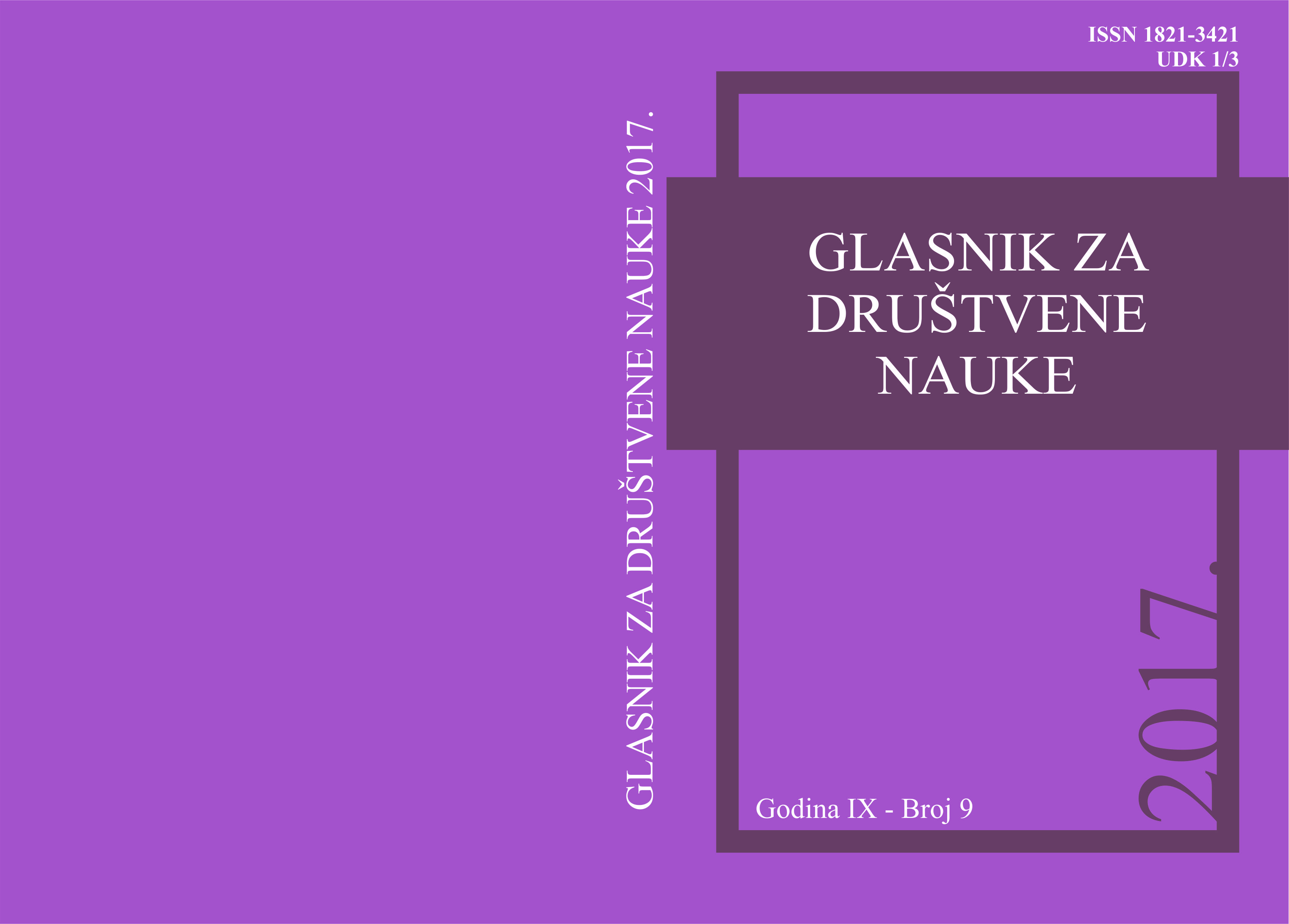KONCEPT INTEGRATIVNE ZAŠTITE U NOVIM AKADEMSKIM STUDIJAMA HERITOLOGIJE-ZAŠTITE NASLEĐA NA ALFA BK UNIVERZITETU
Ključne reči:
integrativna zaštita, održivi razvoj, heritologija, akademsko obrazovanje.Apstrakt
Osnovni zadatak novih studija iz Heritologije je ovladavanje konceptom integrativne zaštite nasleđa, objedinjene brige za kulturno i prirodno nasleđe zajedno. Ovakav pristup je sastavni i ravnopravni deo održivog razvoja koji čine ekonomski prosperitet, društvena harmonija i očuvanje životnog okruženja čoveka (zajednička briga za kulturno i prirodno nasleđe). Osnovnu strukturu studija čine četiri sadržajne celine, međusobno povezane i isprepletane: Materijalno nasleđe, Nematerijalno nasleđe, Prirodno nasleđe, Upravlјanje nasleđem. Program je interdisciplinarnog karaktera i pruža akademsko obrazovanje i praktičnu obuku preko različitih sadržaja i metoda iz oblasti DHP, PMP, TTP nauka i Umetničkog polјa. Studije treba da osposobe studente da direktno povežu teoriju, metodologiju i praksu konzervacije sa valorizacijom vrednosti koje moraju da se čuvaju, fizičko hemijskim, biološkim i tehnološkom istraživanjima i konzervatorskim metodama preventivne konzervacije, kurativne konzervacije i restauracije; dokumentacije, promocije, prezentacije. Studije, takođe treba da osposobe studente da u okviru lokalne i nacionalne zajednice razvijaju svest o potrebi za sistematskom brigom o sopstvenom nasleđu, jer je nasleđe veoma osetlјivo na neodgovarajuće rukovanje i upravlјanje i na različite materijalne i nematerijalne uticaje iz okruženja...
Reference
2. Antomarchi, C., Guichen de, G. (1987). Pour une nouvelle approche des norms climatiques dans les museés. Los Angeles: Getty Conservation Institute.
3. Architecture et du patrimoine. (2004). Ministère de la Culture et de la Communication de France. Paris:Direction de l’ architecture et du patrimoine.
4. Ashley-Smith, J. (1999). Risk assessment for object conservation. Oxford:Butterwerth-Heinemann.
5. Ayerst, G. (1968). Prevention of biodeterioration by control environmental conditions, Biodeterioration of materials, Amsterdam.
6. Barros, A. (2013). D'Sa Adhesives and Consolidants in Painting Conservation. Archetype Publication.
7. Belij, S. (2008). Stanje i zaštita geodiverziteta i objekata geonasleđa u Srbiji, Zaštita prirode, 60(1-2), Beograd.
8. Berducou, M. C. (1990). La Conservation en archéologie: méthodes et pratique de la conservation-restauration des vestiges archéologiques, Paris.
9. Bernice, L. Murphy (2016). Museums, Ethics and Cultural Heritage. London-New York: Routledge.
10. Bonita, M. Kolb. (2013). Marketing for Cultural Organizations, New Strategies for Attracting.
11. Bošković, Đ. (1957). Arhitektura srednjeg veka. Beograd: Naučna knjiga.
12. Bradley, S. (2003). The interface between Science and Conservation, The British Museum, Occasional paper Number 116, London.
13. Brandi, C. (1963). Teoria del restauro. Torino: Giulio Einaudi Editore.
14. Brandi, C. (1977). Teoria del restauro. Torino: Giulio Einaudi Editore.
15. Brandi, C. (2000). Teoria del restauro. Torino: Giulio Einaudi Editore.
16. Brandi, C. (2007). Teorija Restauracije. Beograd: Ministarstvo kulture Republike Srbije.
17. Brguljan, V. (1985). Uvod u međunarodni sistem zaštite kulturnih dobara. Međunarodni sistem zaštite prirodnih i kulturnih dobara, Beograd-Zagreb.
18. Brilha, J. (2002). Geoconservation and protected areas. Environmental Conservation, 29(3), 273-276.
19. Cassar, M. Pender R. (2005). The impact of climate change on cultural heritage: evidence and response, ICOM CC 14 the Triennial Meeting The Hague, ICOM, 2. Retrieved from: http://citeseerx.ist.psu.edu/viewdoc/download?doi=10.1.1.624.328&rep=rep1&type=pdf
20. Ćemalović, U. (2014). Proces usklađivanja domaćeg pravnog sistema sa pravom Evropske unije – stanje, problemi i moguća rešenja. Beograd: Kultura polisa XI/2014.
21. Convention for Safeguarding of the Intangible Heritage. (2004). 20th General Conference. 21st General Assembly ICOM, Seoul.
22. Correia, M. Dipasquale, L., Mecca, M. (2014). Heritage for tomorrow: Vernacular Knowledge for Sustainable Architecture Versus. Firenze: University Press.
23. Dardes, K., Rothe, A. (1998). The Structural Conservation of Panel Paintings. Getty Publications.
24. Declaration of Amsterdam, Congresson the European Architectural Heritage, Council of Europe. (1975). Amsterdam. Retrieved from:
www.icomos.org/dosc/amsterdam.htm.
25. Đorđević, B. (2011). Tri lica tradicionalne keramičke proizvodnje u Srbiji. Beograd: Narodni muzej u Beogradu.
26. Đorđević, B. (2012). Nematerijalno kulturno nasleđe – analiza pravnog okvira na primeru tradicionalne keramičke proizvodnje. Beograd: Narodni muzej u Beogradu.
27. Đurić, V. J., Ćirković, S., Korać, V. (1990). Pećka patrijaršija. Beograd: Jugoslovenska revija; Priština: Jedinstvo.
28. Dragičević-Šešić, M., Dragojević S. (2005). Menadžment umetnosti u turbulentnim okolnostima. Beograd: CLIO.
29. ECCRO Professional Guidelines. (1 March 2002). European Confederation of Conservator Restorers̉’Organisation, ECCRO- General Assembly, Brussels.
30. Ellison, R., Smithen, P., Turnbull, R. (2010). Mixing and Matching: Approaches to Retouching Paintings. USA & Canada: Archetype Publications.
31. English Heritage. (2008). Energy conservation in traditional buildings, Application of Part L of the Building Regulations to historic and traditionally constructed building.
32. English Heritage. (2011). Energy Efficiency and Historic Buildings, Application of Part L of the Building Regulations to historic and traditionally constructed building.
33. European Preventive Conservation Strategy Project, (2000). Vanta Document 21-22 septembar 2000. Rome: ICCROM-International Centre for Study of the Preservation and Restoration of Cultural Proprety.
34. Feilden, M. B. (2003). Conservation of Historic Buildings, Architectural Press. Oxford.
35. Fèrault Marie-Agnès (2001). Les Zones de Protection du Patrimoine architectural, urbain et paysager. Paris: Ministère de la Culture et de la Communication France, Direction de l’Architecture et du Patrimoine; Ministère de l’Aménagement du Territoire et de l’Environnement, Direction de la Nature et des Paysages.
36. Filomena Guerra, M., Calligaro, T. (2003). Gold cultural heritage objects: a review of studies of provenance and manufacturing technologies, Institute of Physics publishing Measurement science and technology 14.
37. Forsyth, M. (2007). Understanding historic building conservation. Oxford: Blackwell.
38. French, Y., Runyard, S. (2011). Marketing and Public Relations for Museums, Galleries, Cultural and Heritage.
39. Gavrilović, D., Belij, S., & Mijović, D. (1998). Inventory of geomorphological heritage of Serbia as a base for protection of geomorphological features, Geologica Balcanica, 28, 3-4.
40. Gray, M. (2013). Geodiversity, Valuing and Conserving Abiotic Nature, Wiley-Blackwell, Oxford.
41. Greffe, X. (2003). La valorisation économique du patrimoine. La Documentation française, Paris:La Documentation Française.
42. ICOM. (2003). Kodeks profesionalne etike. Beograd: NC ICOM Srbija.
43. ICOM. (2006). .International Journal of Intangible Heritage.
44. Jokilehto, J. (2002). A History of Architectural Conservation. England: Institute of advanced Architectural Studies.
45. Jovičić, D., i Ilić, T. (2010). Indikatori održivog turizma, Glasnik Srpskog geografskog društva, sveska HS, 1, Beograd.
46. Kaiser, C. (2006). Landscape as Heritage: Negotiating European Cultural Identity, EUI Working papers, RSCAS No. 2006/05, European University Institute - Robert Schuman Centre for Advanced Studies.
47. Kostof, S. (1991). The City Shaped - Urban Patterns and Meanings Through History. London:Thames und Hudson.
48. Kostof, S. (1995). A History of Architecture, Settings and Rituals. Oxford University Press.
49. Kotler, Ph., Armstrong, G. (2014). Principles of Marketing. Prentice Hall: Pearson.
50. Legal and Practical Measures Against Illicit Trafficking in Cultural Property. (2006). UNESCO Handbook, International Standards Section Division of Cultural Heritage.
51. Letellier, R. (2007). Recording, Documentation, and Information Management for the Conservation of Heritage Places. Los Angeles: The Getty Conservation Institute.
52. Lima, D., Soesbergen, V. (2014). Tracking progress towards global targets for protected areas, Protected Planet Report 2014, UNEP World Conservation Monitoring Centre.
53. Logan,W., Nic Craith, M., Kockel, U. (2016). A Companion to Heritage Studies. Wiley Blackwell: Intercultural Research Centre.
54. Maksin, M., Pucar, M., Korać, M., Milijić, S. (2009). Menadžment prirodnih i kulturnih resursa u turizmu. Beograd: Fakultet za turistički i hotelijerski menadžment.
55. May, E., Jones, M. (2006). Conservation Science, Heritage Materials. Cambridge: Royal Society of Chemistry.
56. Menegazzi, C. (2003). Cultural Heritage Disaster Preparedness and Response. ICOM, International Symposium 23-27 November 2003. India: Salar Jung Museum Hyderabad.
57. Nenadović, S. (1980). Zaštita graditelјskog nasleđa. Beograd.
58. Newsome D., Dowling R. K. (2010). Geotourism: The Tourism of Geology and Landscape. Oxford:Goodfellow Publishers. 59. Nicolaus, K. (1999). The Restoration of Paintings. Könemann.
60. Orbasli, A. (2008). Architectural conservation: Principles and Practice. Oxford: Wiley-Blackwell.
61. Petrović, N. (2007). Ekološki menadžment. Beograd: Fakultet organizacionih nauka.
62. Popović-Živančević, M. (2011). Muzeji i nematerijalna baština, Nematerijalno kulturno nasleđe Srbije, Integible Cultiuiral Heritage of Serbia, 1, Ministarstvo kulture, informisanja i informacijskog društva Republike Srbije, Beograd: Centar za zaštitu nematerijalnog nasleđa.
63. Popović–Živančević, M. (1994). Konzervacija keramike Đerdapa II. Monografija. Beograd: Radovi Centra za konzervaciju Narodnog muzeja.
64. Popović-Živančević, M. (2007). Regionalna publikacija “Revitalizacija kulturnog i prirodnog nasleđa u regiona Balkana-jugoistočne Evrope“, Zbornik radova Regionaolne konferencije „Stanje kulturne i prirodne baštine u regionu Balkana“, 23-28 oktobar 2006. Beograd:Narodni muzej u Beogradu, ICOM SEE, BRESCE-UNESCO iz Venecije.
65. Popović-Živančević, M. (2010). Preventivna konzervacija u muzejima. Monografija. Beograd: Centralni institut za konzervaciju, institut Goša.
66. Popović–Živančević, M. (2013). Integrativna zaštita baštine sa metodologijom preventivne konzervacije. Monografija. Beograd: Centralni institut za konzervaciju.
67. Popović-Živančević, M. (2015). Jedinstven sistem zaštite za prirodno i kulturno nasleđe zajedno. Glasnik Društva konzervatora Srbije, 37, Beograd.
68. Seoul Declaration. (2004). ICOM, Museums and Intangible Heritage, 20th ICOM General Conference, 8th October 2004., Seoul, Rep.of Korea.
69. ″Službeni glasnik RS″, br. 71/94. (1994). Zakon o kulturnim dobrima. Beograd: Službeni glasnik Republike Srbije.
70. ″Službeni glasniku RS″ - Međunarodni ugovori", br. 1. (2010). Zakon o potvrđivanju Konvencije o očuvanju nematerijalnog kulturnog nasleđa. Beograd: Službeni glasnik Republike Srbije.
71. Stojanović, V. (2006). Održivi razvoj turizma i životne sredine. Novi Sad: Prirodno-matematički fakultet. 72. Stoner, J. H., Rushfield, R. (2013). Conservation of Easel Paintings by Routledge.
73. Šola, T. (2002). Marketing u muzejima. Beograd: CLIO.
74. Šola, T. (2003). Eseji o muzejima i njihovoj teoriji. Zagreb: HNK ICOM.
75. The Resolution of the Council of the European Union on “Architectural quality in urban and rural environments“ of 12 February 2001 (2001/C73/04).
76. UNESCO. (1987). Charter for the Conservation of Historic Towns and Urban Areas. Retrieved from:
www.international.icomos.org/charters/towns_e.htm.
77. UNESCO. (1990). Charter on the Protection and Management of the Archaeological Heritage. Retrieved from:
http://icahm.icomos.org/wp-content/uploads/2017/01/1990-Lausanne-Charter-for-Protection-and-Management-of-Archaeological-Heritage.pdf.
78. UNESCO. (1972). Convention Concerning the Protection of the World Cultural and Natural Heritage. Retrieved from:
https://whc.unesco.org/archive/convention-en.pdf.
79. UNESCO. (2003). Convention for the Safeguarding of the Intangible Heritage. Retrieved from:
https://ich.unesco.org/en/convention.
80. UNESCO. (2004). World Heritage Cultural Landscapes. Retrieved from: http://whc.unesco.org/exibits/cultiand/landscape.htm.
81. Vilus, J. (2007). Pravna zaštita kulturnih dobara. Beograd: Evropski centar za mir i razvoj Univerziteta za mir Ujedinjenih nacija.
82. Vučenović, C. (2004). Urbana i arhitektonska konzervacija – tom 1. Beograd.
83. Vud, M. (2002). Ekoturizam, principi, postupci i politike za održivost. Beograd: Centar za odgovorni i održivi razvoj turizma.
84. Walsh, K. (1992). The Representation of the Past, Museums and Heritage in the Post-Modern World. London-New York: Routledge.
85. Wu, B. (1992). Manufacturing Systems design and Analysis. UK: Champan and Hall.
86. Zoric, V. M. (2009). Analiza mehaničkih oscilacija obojenih slojeva i metod primene rezultata u forenzičkim istraživanjima. Novi Sad.
87. Zoric, V. M. (2014). Forenzička istraživanja obojenih slojeva. Beograd: Zadužbina Andrejević.
88. http: // www.culture.coe.fr/pat/eng/patlist. 89. www.international.icomos.org/charters/arch_e.htm.
90. http://www.kultura.gov.rs/docs/stranice/82128418889499865927/11.%20Konvencija%20o%20ocuvanju%20nematerijalnog%20kulturnog%20nasledja%20%28Pariz%202003%29.pdf.


